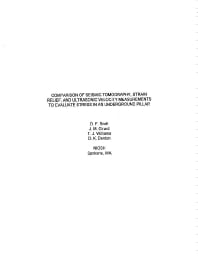Mining Publication: Comparison of Seismic Tomography, Strain Relief, and Ultrasonic Velocity Measurements to Evaluate Stress in an Underground Pillar
Original creation date: March 1999
Authors: DF Scott, JM Girard, TJ Williams, DK Denton
Society for Mining, Metallurgy, and Exploration, Inc. (SME) Annual Meeting (Mar 1-3, 1999; Denver, CO); SME Preprint 99-155
Personnel from the Spokane Research Laboratory, National Institute for Occupational Safety and Health, examined an underground pillar at the Homestake Mine, Lead, SD. Investigations involved strain relief and seismic tomography studies in the mine, and ultrasonic velocity measurements on pillar core in the laboratory. Measured octahedral normal stress was 37 MPa (5,366psi); seismic P-wave velocities averaged 5.2 km/s (17,060 ft/s); and ultrasonic velocities at a pressure of 39.6 MPa (5,750 psi) averaged 6.3 km/s (20,669 ft/s). The difference between in-mine and laboratory velocities is attributed to the attenuation of seismic energy by mine fractures larger and more numerous than those in the samples of core measured in the laboratory. Using these results, researchers hypothesize that pillar rocks have the ability to withstand stress an order of magnitude greater than they currently sustain.

Society for Mining, Metallurgy, and Exploration, Inc. (SME) Annual Meeting (Mar 1-3, 1999; Denver, CO); SME Preprint 99-155
- Advance and Relieve Mining: A Method to Mitigate the Effects of High Horizontal Stress on the Mine Roof
- Assessment of Stable and Failed Pillars in Underground Limestone Mines
- Behavior of a Coal Pillar Prone to Burst in the Southern Appalachian Basin of the United States
- Coal Bumps and Odd Dynamic Phenomena - A Numerical Investigation
- Effects of Weak Bands on Pillar Stability in Stone Mines: Field Observations and Numerical Model Assessment
- Field Observations and Numerical Studies of Horizontal Stress Effects on Roof Stability in U.S. Limestone Mines
- Pillar Design Issues for Underground Stone Mines
- Pillar Stability Issues Based on a Survey of Pillar Performance in Underground Limestone Mines
- Three Dimensional Microseismic Monitoring of a Utah Longwall
- The Unpredictable Life Cycle of a Coal Pillar